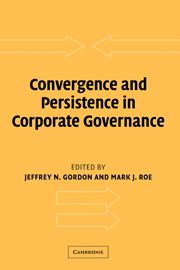Book contents
- Frontmatter
- Contents
- List of figures
- List of tables
- List of contributors
- Acknowledgments
- Introduction
- PART I Systemic issues
- PART II Government players
- 5 The international relations wedge in the corporate convergence debate
- 6 Property rights in firms
- 7 Modern politics and ownership separation
- PART III Specific institutions
- Index
6 - Property rights in firms
Published online by Cambridge University Press: 04 March 2010
- Frontmatter
- Contents
- List of figures
- List of tables
- List of contributors
- Acknowledgments
- Introduction
- PART I Systemic issues
- PART II Government players
- 5 The international relations wedge in the corporate convergence debate
- 6 Property rights in firms
- 7 Modern politics and ownership separation
- PART III Specific institutions
- Index
Summary
Introduction
Property rights are where the whole debate began. Berle and Means unwittingly set the stage for modern-day comparative corporate law scholarship in 1932 with a straightforward and powerfully compelling theory rooted, as they put it, in “the traditional logic of property”: to fulfill the need for vast pools of capital, firms issue shares to large numbers of dispersed shareholders; scattered ownership allows control to concentrate in the hands of managers. Corporate governance, in this universe, focuses on aligning the interests of shareholder “owners” who provide the capital and corporate managers who run the firm.
Some sixty years after this initial insight, legal scholars, beginning with Mark Roe, pointed out in equally compelling terms that the logic of Berle and Means skips a crucial step: in some economies, powerful financial intermediaries take the place of organized stock exchanges as the chief mechanism for raising capital. In these economies, banks may have the information and incentives to monitor firms, and the problem around which a half-century of American corporate law theory is built fades in importance.
Explicit in this view is a powerful but narrow perspective on diversity in national corporate governance systems. On the theory that “finance determines governance,” prominent scholarship has focused on the way political and historical idiosyncracies have shaped the law of financial institutions and the resulting ownership structure of large corporations.
- Type
- Chapter
- Information
- Convergence and Persistence in Corporate Governance , pp. 210 - 251Publisher: Cambridge University PressPrint publication year: 2004
- 4
- Cited by

